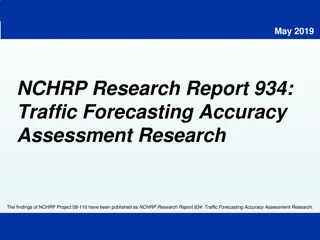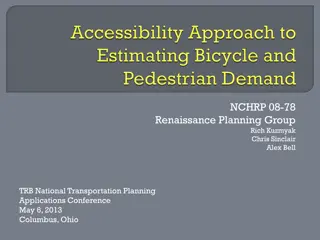Proposed Guidance for Fixed Objects in Roadside Design
This presentation covers the development of design guidance aimed at mitigating collisions with roadside fixed objects, focusing on trees and utility poles. With a high number of traffic fatalities resulting from roadway departures involving such objects, the research objective is to provide engineering practitioners with tools to quantify collision risks. The outline includes chapters on design criteria, crash reduction programs, benefit-cost analysis, and crash prediction models.
Download Presentation

Please find below an Image/Link to download the presentation.
The content on the website is provided AS IS for your information and personal use only. It may not be sold, licensed, or shared on other websites without obtaining consent from the author.If you encounter any issues during the download, it is possible that the publisher has removed the file from their server.
You are allowed to download the files provided on this website for personal or commercial use, subject to the condition that they are used lawfully. All files are the property of their respective owners.
The content on the website is provided AS IS for your information and personal use only. It may not be sold, licensed, or shared on other websites without obtaining consent from the author.
E N D
Presentation Transcript
Proposed Guidance for Fixed Objects in the Roadside Design Guide NCHRP Project 17-82
This slide presentation was developed by MRIGlobal under NCHRP Project 17-82. More information about this topic can be found in NCHRP Research Report 1016: Design Guidelines for Mitigating Collisions with Trees and Utility Poles on the National Academies Press website (www.nap.edu). NCHRP is sponsored by the individual state departments of transportation of the American Association of State Highway and Transportation Officials. NCHRP is administered by the Transportation Research Board (TRB), part of the National Academies of Sciences, Engineering, and Medicine, under a cooperative agreement with the Federal Highway Administration (FHWA). Any opinions and conclusions expressed or implied in resulting research products are those of the individuals and organizations who performed the research and are not necessarily those of TRB; the National Academies of Sciences, Engineering, and Medicine; FHWA; or NCHRP sponsors.
Background 18,000 traffic fatalities per year result from roadway departures - Over 7,000 of these involve collisions with roadside fixed objects. - Trees are the roadside fixed object most frequently involved in fatal crashes. - The second type of roadside fixed object most commonly struck in fatal crashes are utility poles and light supports. Given the scale of our roadway system, the diverse nature of existing roadsides, and the limited funds for safety improvement, not every roadside can be treated or mitigated to provide the full clear zone. Highway agencies need to be able to establish priorities for roadside improvements.
Research Objective To develop design guidance for use by engineering practitioners to quantify the relative risk of collisions with roadside fixed objects.
Research Focus Fixed objects on the outside of the roadway (i.e., on the right side of the road on divided highways and on both sides of the road on undivided highways). - Fixed objects in the median can be addressed through interpretation of the results for roadside fixed objects outside of the roadway(s). Trees and utility poles on the following roadway types: - Rural two-lane highways - Rural multilane undivided highways - Rural multilane divided highways
Outline of Design Guidelines Chapter 1 Introduction Chapter 2 Design Criteria for Clear Zones Chapter 3 Crash Reduction Programs for Roadside Trees and Utility Poles Chapter 4 Relationship of Presence of Roadside Trees and Utility Poles to Crash Frequency and Severity Chapter 5 Recommended Benefit-Cost Analysis Method Chapter 6 Benefit-Cost Analysis Examples References Appendix A Recommended Crash Prediction Model for Tree- and Utility-Pole-Related Crashes Appendix B Predicting the Frequency and Severity of Tree- and Utility-Pole-Related Crashes with the Accompanying Spreadsheet Tool
Chapter 1 Introduction Presents basic crash history data 18,000 roadway departure fatalities per year 7,000 roadside fixed-object fatalities per year 3,500 fatalities per year involving roadside trees 820 fatalities per year involving roadside utility poles and light supports Explains role of roadside improvement program References key role of the AASHTO RDG Presents organization of remainder of design guidelines document
Chapter 2 Design Criteria for Clear Zones Summarizes AASHTO RDG guidance on clear zones including suggested clear-zone distance and horizontal curve adjustment factors
Chapter 3 Crash Reduction Programs for Roadside Trees and Utility Poles Roadside trees includes existing material about trees from RDG Section 4.9 includes new material about trees from benefit-cost analysis examples (Chapter 5 of design guidelines) Utility poles includes existing material about utility poles from RDG Section 4.8 includes new material about utility poles from benefit-cost analysis examples (Chapter 5 of design guidelines)
Chapter 4 Relationship of Presence of Roadside Trees and Utility Poles to Crash Frequency and Severity Presents brief review of literature/existing models Presents a new recommended crash prediction model developed in the research a modified version of the Road Assessment Program (RAP) model: predicts annual frequency of fatality and injury (FI) crashes related to trees or utility poles applicable to rural two-lane undivided highways, rural four-lane undivided highways, rural four-lane divided highways (nonfreeways)
Chapter 4 Relationship of Presence of Roadside Trees and Utility Poles to Crash Frequency and Severity Safety Performance Functions (SPFs) consider: motor-vehicle traffic volume (AADT) number of objects on left and right sides of the road number of individual objects (trees or utility poles) length of continuous tree groups (converted to an equivalent number of individual trees) calibration factors for trees and utility poles (based on data collected and analyzed in this research) Adjustment Factors (AFs): roadway design speed traffic flow influence factor median traversability factor crash likelihood factors crash severity factors
Chapter 4 Relationship of Presence of Roadside Trees and Utility Poles to Crash Frequency and Severity Crash Likelihood Factors: lane width horizontal curvature advance visibility of curve percent grade presence of shoulder rumble strips presence of delineation road surface condition pavement skid resistance Crash Severity Factors: type of roadside object distance from traveled way to roadside object paved shoulder width
Chapter 4 Relationship of Presence of Roadside Trees and Utility Poles to Crash Frequency and Severity Model Outputs predicted number of FI run-off-road tree-related (or utility-pole-related) crashes per year (NROR) predicted number of FI tree-related (or utility-pole-related) crashes per year by crash severity level: fatal (K-injury) crashes incapacitating injury (A-injury) crashes nonincapacitating injury (B-injury) crashes possible injury (C-injury) crashes predicted number of persons injured in tree-related (or utility-pole-related) crashes per year: persons with fatal injuries (K injuries) persons with incapacitating injuries (A injuries) persons with nonincapacitating injuries (B injuries) persons with possible injuries (C injuries)
Chapter 4 Relationship of Presence of Roadside Trees and Utility Poles to Crash Frequency and Severity Model predictions can be expressed as a crash modification factor (CMF): CMF = NRORfor potential improved design / NRORfor existing or planned design
Chapter 5 Benefit-Cost Analysis Method Benefit-Cost Ratio: Benefits / Costs ??????? ??? ? ?,?%,? ?/? = ?? Net Benefits: Benefits - Costs ?? = ??????? ??? ? ?,?%,? ??
Chapter 5 Benefit-Cost Analysis Method Elements of Benefit-Cost Analysis Method annual number of crashes reduced crash costs by crash severity level (based on 2018 FHWA publication by Harmon et al.) improvement service life (default value: 20 years) discount rate or minimum attractive rate of return (default value: 7%) uniform series present worth factor present value of crash reduction benefits implementation cost for proposed improvement
Chapter 6 Benefit-Cost Analysis Examples Computations illustrated for five (5) benefit-cost examples All examples related to roadside fixed objects on rural two-lane undivided highways Range of conditions considered: Two-way traffic volume (AADT) equal to 1,000, 5,000, and 10,000 veh/day Distance from traveled way to roadside object: 6, 10, 15, 20, 25, 30, 35, and 40 ft Roadway characteristics for all examples 70-mph design speed 12-ft lanes, 6-ft paved shoulders Tangent alignment 2% grade Good delineation, road surface condition, and pavement skid resistance
Chapter 6 Benefit-Cost Analysis Examples Benefit-Cost Example #1 Removal of an Isolated Roadside Tree Removal of a single, isolated roadside tree on a rural two-lane highway Annual crash reduction (crashes/yr)a Benefit-cost ratio Distance from Traveled Way to Tree (ft) 6 10 15 20 25 30 35 40 a For all fatal and injury crash severity levels combined. Traffic volume (AADT) (veh/day) 10,000 0.0061 0.0103 0.0053 0.0088 0.0041 0.0070 0.0030 0.0051 0.0022 0.0037 0.0017 0.0029 0.0012 0.0020 0.0007 0.0013 1,000 0.0013 0.0011 0.0009 0.0007 0.0005 0.0004 0.0003 0.0001 5,000 1,000 7.8 6.7 5.3 3.9 2.8 2.2 1.5 0.9 5,000 36.3 31.1 24.5 18.3 13.2 10.2 7.2 4.1 10,000 61.0 52.7 41.2 30.7 22.2 17.1 12.0 7.0
Chapter 6 Benefit-Cost Analysis Examples Benefit-Cost Example #2 Removal of an Continuous Tree Group Removal of a continuous tree group, 0.5 miles in length, spaced at intervals of 5 ft, on a rural two-lane highway Annual crash reduction (crashes/yr)a Benefit-cost ratio Distance from Traveled Way to Tree (ft) 6 10 15 20 25 30 35 40 a For all fatal and injury crash severity levels combined. Traffic volume (AADT) (veh/day) 10,000 0.2638 0.2258 0.1782 0.1307 0.0959 0.0739 0.0520 0.0301 1,000 0.0336 0.0288 0.0227 0.0167 0.0122 0.0094 0.0066 0.0038 5,000 0.1571 0.1345 0.1061 0.0778 0.0571 0.0440 0.0310 0.0179 1,000 0.8 0.6 0.5 0.4 0.3 0.2 0.1 0.1 5,000 3.5 3.0 2.4 1.7 1.3 1.0 0.7 0.4 10,000 5.9 5.1 4.0 2.9 2.2 1.7 1.2 0.7
Chapter 6 Benefit-Cost Analysis Examples Benefit-Cost Example #3 Relocation of a Single Utility Pole Removal of a single utility pole on a rural two-lane highway Annual crash reduction (crashes/yr)a Benefit-cost ratio Distance from Traveled Way to Tree (ft) 6 10 15 20 25 30 35 40 For all fatal and injury crash severity levels combined. Traffic volume (AADT) (veh/day) 10,000 0.0060 0.0101 0.0051 0.0086 0.0041 0.0068 0.0030 0.0050 0.0022 0.0037 0.0017 0.0028 0.0012 0.0020 0.0007 0.0012 1,000 0.0013 0.0011 0.0009 0.0006 0.0005 0.0004 0.0003 0.0001 5,000 1,000 0.4 0.4 0.3 0.2 0.1 0.1 0.1 < 0.1 5,000 1.9 1.6 1.3 0.9 0.7 0.5 0.4 0.2 10,000 3.2 2.7 2.2 1.6 1.2 0.9 0.6 0.4 a
Chapter 6 Benefit-Cost Analysis Examples Benefit-Cost Example #4 Relocation of an Extended Series of Utility Poles Relocation of a series of 9 utility poles spaced at 300-ft intervals over 0.5 miles of a rural two-lane highway Annual crash reduction (crashes/yr)a Benefit-cost ratio Distance from Traveled Way to Tree (ft) 6 10 15 20 25 30 35 40 a For all fatal and injury crash severity levels combined. Traffic volume (AADT) (veh/day) 10,000 0.0909 0.0778 0.0614 0.0450 0.0330 0.0255 0.0179 0.0104 1,000 0.0116 0.0099 0.0078 0.0057 0.0042 0.0032 0.0023 0.0013 5,000 0.0541 0.0463 0.0366 0.0268 0.0197 0.0152 0.0107 0.0062 1,000 1.7 1.5 1.2 0.9 0.6 0.5 0.3 0.2 5,000 8.0 6.9 5.4 4.0 2.9 2.2 1.6 0.9 10,000 13.5 11.5 9.1 6.7 4.9 3.8 2.7 1.5
Chapter 6 Benefit-Cost Analysis Examples Benefit-Cost Example #5 Relocation of an Extended Series of Utility Poles and Replacement with Underground Utilities Relocation of a series of 9 utility poles spaced at 300-ft intervals over 0.5 miles of a rural two-lane highway and replacement with underground utilities Annual crash reduction (crashes/yr)a Benefit-cost ratio Distance from Traveled Way to Tree (ft) 6 10 15 20 25 30 35 40 a For all fatal and injury crash severity levels combined. Traffic volume (AADT) (veh/day) 10,000 0.0909 0.0778 0.0614 0.0450 0.0330 0.0255 0.0179 0.0104 1,000 0.0116 0.0099 0.0078 0.0057 0.0042 0.0032 0.0023 0.0013 5,000 0.0541 0.0463 0.0366 0.0268 0.0197 0.0152 0.0107 0.0062 1,000 < 0.1 < 0.1 < 0.1 < 0.1 < 0.1 < 0.1 < 0.1 < 0.1 5,000 0.2 0.2 0.1 0.1 0.1 0.1 < 0.1 < 0.1 10,000 0.3 0.3 0.2 0.2 0.1 0.1 0.1 < 0.1

















